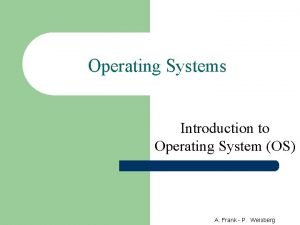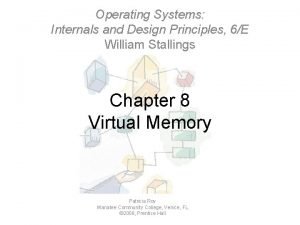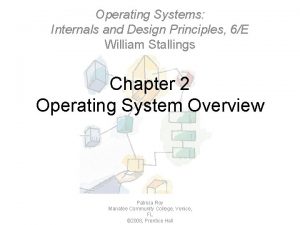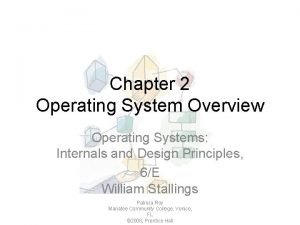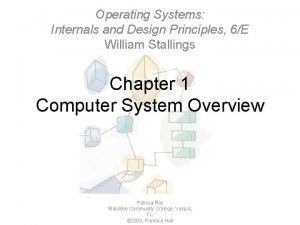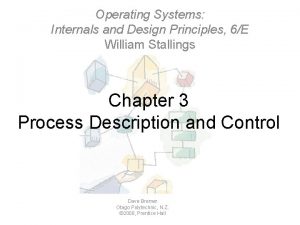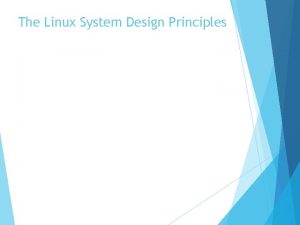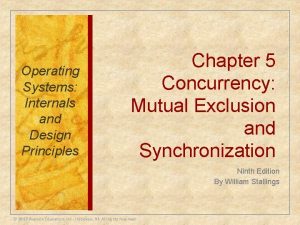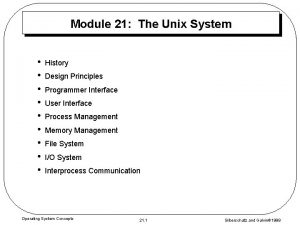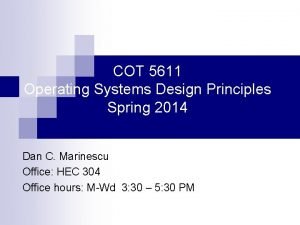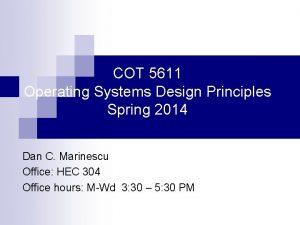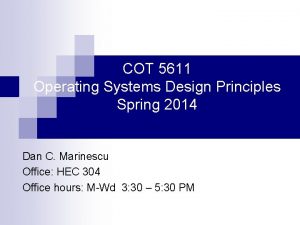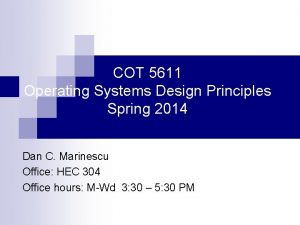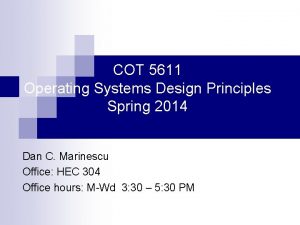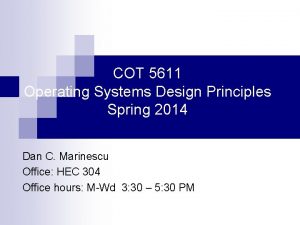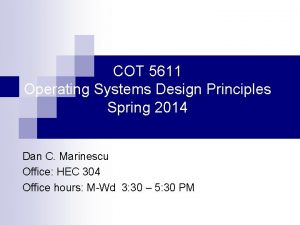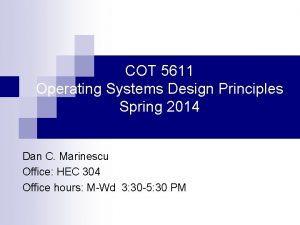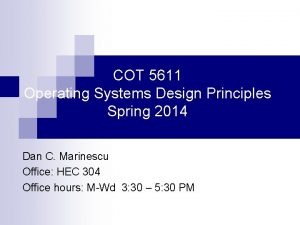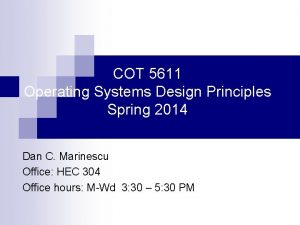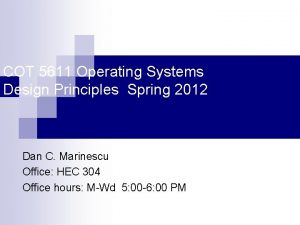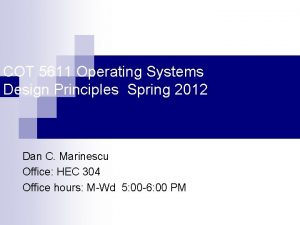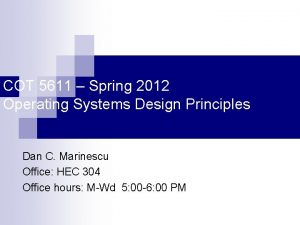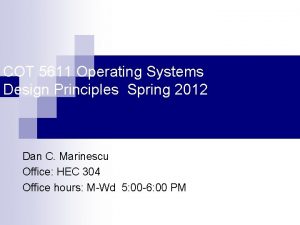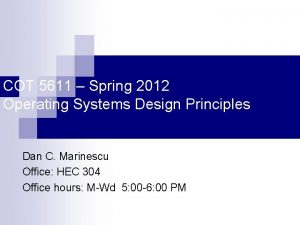COT 5611 Operating Systems Design Principles Spring 2014


















- Slides: 18

COT 5611 Operating Systems Design Principles Spring 2014 Dan C. Marinescu Office: HEC 304 Office hours: M-Wd 3: 30 -5: 30 PM

Lecture 2 n Reading assignment: class slides 1. 2. Man-made systems and the environment Complex systems 1. Factors affecting complexity 2. Sources of complexity 3. Coping with complexity 1. 2. 3. 4. Characteristics of complex systems 1. 2. 3. 9/3/2021 Modularity Abstractions Hierarchy Propagation of effects Incommensurate scaling Tradeoffs Lecture 2 2

Systems and the environment n n n System a set of interconnected components that has a an expected behavior observed at the interface with its environment The environment a critical component to be considered in the design of any system The systems we are concerned consist of ¨ hardware and ¨ software 9/3/2021 Lecture 2 3

Man-made systems n n n Basic requirements for man-made systems: ¨ Functionality ¨ Performance ¨ Cost All systems are physical the laws of physics governing the functioning of any system must be well understood. Physical resources are limited. 9/3/2021 Lecture 2 4

Complex systems n n n Large number of components Large number of interconnections Many irregularities Long description For man-made systems: a team of designers, implementers, and maintainers. 9/3/2021 Lecture 2 5

Issues faced by the designer of a complex system n n Emerging Properties Propagation of effects Incommensurate scaling Tradeoffs 9/3/2021 Lecture 2 6

Emerging properties n n A characteristic of complex systems properties that are not evident in the individual components but show up when the components interact with one another. Example: you have several electronic components which radiate electromagnetic energy; if they are too close to one another their function are affected. 9/3/2021 Lecture 2 7

Two sources of complexity 1. Cascading and interacting requirements ¨ 1. 1 When the number of requirements grows then the number of exception grows. ¨ 1. 2 The principle of escalating complexity: 1. 3 Meeting many requirements with a single design the need for generality. Advice: avoid excessive generality. ¨ 1. 4 Requirement changes. Example: the electric car by Tesla. ¨ 9/3/2021 Lecture 2 8

Two sources of complexity (cont’d) n 2. High performance 2. 1 Every system must satisfy performance standards. ¨ 2. 2 The law of diminishing return the more one improves one performance metrics the more effort the next improvement will require ¨ 9/3/2021 Lecture 2 9

Modularity for Coping with Complexity n n Why does modularity reduce complexity we can focus on the interaction within one module/component. Example: assume that: N , the number of statements of a program ¨ B - the # of bugs in a program proportional with N ¨ T- the time to debug a program proportional with N x B thus, with N 2 ¨ Now we divide the program in K modules n Each module has n=N/K statements n t, the time to debug a module proportional with n 2=(N/K)2 n �� , the time to debug the K modules proportional with K x t = K x (N/K)2 = N 2/K n We have reduced the time by a factor of K. Is that so? ¨ 9/3/2021 Lecture 2 10

Abstractions and Coping with Complexity n Abstraction separation of the interface from the internals or ¨ specification from implementation Example: you do not need to know how the engine of your car works in order to drive the car ¨ n n Why abstractions reduce complexity because they minimize the interconnections between components. Observations: Best division usually follows natural boundaries. ¨ The goal is defeated by unintentional or accidental interconnections among components. ¨ 9/3/2021 Lecture 2 11

More about abstractions • Abstractions are critical for understanding critical phenomena. Think about the abstract model of computation provided by the Turing Machine. • Do not be carried away by abstractions. For example, often software designers think about an abstract computer and are not concerned about the physical resources available to them. E. g. , the small display of a wireless phone. 9/3/2021 Lecture 2 12

Robustness band safety margin principles n The robustness principle be tolerant of inputs and strict on outputs. n The safety margin principle Keep track of the safety margin of the cliff or you may fall over edge!! 9/3/2021 Lecture 2 13

Layering for Coping with Complexity n n Layering building a set of successive functional entities with restricted communication patterns, a layer may only communicate with the layer below it and with the one above it. Examples: networking 9/3/2021 Lecture 2 14

Hierarchy for Coping with Complexity n n Hierarchical structures construct a large system from a small collection of relatively large subsystems Examples: Corporations ¨ An army ¨ A computer is a collection of subsystems ¨ 9/3/2021 Lecture 2 15

Propagation of effects n In a complex system: Changes of one component affect many other components. Example, changing the size of the tire of a car. ¨ A problem affecting one component propagates to others. For example, the collapse of the housing industry in the US affected the economy of virtually all countries in the world. ¨ 9/3/2021 Lecture 2 16

Incommensurate scaling n n Not all components of a complex system follow the same scaling rules. Examples: ¨ The pyramids ¨ The tankers The power dissipation increases as (clock rate)3. If you double the clock rate, then the power dissipation increases by a factor of 8 so you need a heat removal system 8 times more powerful. 9/3/2021 Lecture 2 17

Trade-offs n n Many tradeoffs are involved in the design of any system Examples: a network switch what should be done in hardware and what should be done in software ¨ a hybrid car with a gas and an electric engine how powerful should the gas engine be ¨ a spam filter where to set the threshold ¨ 9/3/2021 Lecture 2 18
 Reisvoorziening duo
Reisvoorziening duo Operating system internals and design principles
Operating system internals and design principles Slidetodoc.com
Slidetodoc.com Operating systems: internals and design principles
Operating systems: internals and design principles Operating systems: internals and design principles
Operating systems: internals and design principles Operating systems: internals and design principles
Operating systems: internals and design principles Operating systems internals and design principles
Operating systems internals and design principles Operating systems internals and design principles
Operating systems internals and design principles Hisd calendar
Hisd calendar Linux design principles in os
Linux design principles in os Operating system internals and design principles
Operating system internals and design principles Design principles of unix operating system
Design principles of unix operating system Design issues of distributed file system
Design issues of distributed file system Spring, summer, fall, winter... and spring (2003)
Spring, summer, fall, winter... and spring (2003) Summer winter spring autumn
Summer winter spring autumn Principles of complex systems for systems engineering
Principles of complex systems for systems engineering Rtgs bd
Rtgs bd Spring information systems
Spring information systems Elements and principles of design ppt
Elements and principles of design ppt


